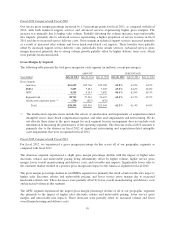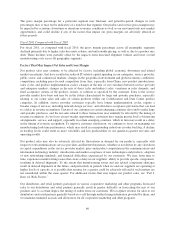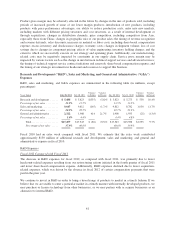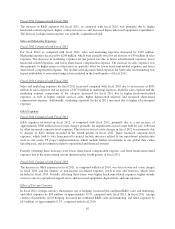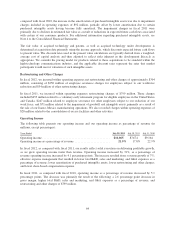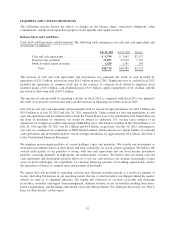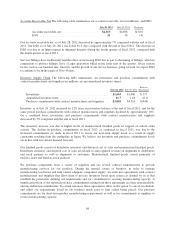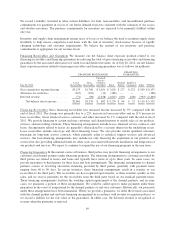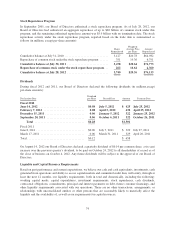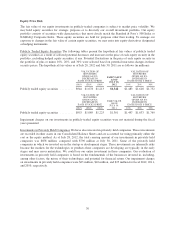Cisco 2012 Annual Report Download - page 77
Download and view the complete annual report
Please find page 77 of the 2012 Cisco annual report below. You can navigate through the pages in the report by either clicking on the pages listed below, or by using the keyword search tool below to find specific information within the annual report.
We record a liability, included in other current liabilities, for firm, noncancelable, and unconditional purchase
commitments for quantities in excess of our future demand forecasts consistent with the valuation of our excess
and obsolete inventory. The purchase commitments for inventory are expected to be primarily fulfilled within
one year.
Inventory and supply chain management remain areas of focus as we balance the need to maintain supply chain
flexibility to help ensure competitive lead times with the risk of inventory obsolescence because of rapidly
changing technology and customer requirements. We believe the amount of our inventory and purchase
commitments is appropriate for our revenue levels.
Financing Receivables and Guarantees We measure our net balance sheet exposure position related to our
financing receivables and financing guarantees by reducing the total of gross financing receivables and financing
guarantees by the associated allowances for credit loss and deferred revenue. As of July 28, 2012, our net balance
sheet exposure position related to financing receivables and financing guarantees was as follows (in millions):
FINANCING RECEIVABLES
FINANCING
GUARANTEES
TOTALJuly 28, 2012
Lease
Receivables
Loan
Receivables
Financed
Service
Contracts
and Other Total
Channel
Partner
End-User
Customers Total
Gross amount less unearned income ...... $3,179 $1,796 $ 2,651 $ 7,626 $ 277 $ 232 $ 509 $ 8,135
Allowance for credit loss .............. (247) (122) (11) (380) — — — (380)
Deferred revenue .................... (71) (98) (1,838) (2,007) (193) (200) (393) (2,400)
Net balance sheet exposure ......... $2,861 $1,576 $ 802 $ 5,239 $ 84 $ 32 $ 116 $ 5,355
Financing Receivables Gross financing receivables less unearned income increased by 9% compared with the
end of fiscal 2011. The change was primarily due to a 22% increase in loan receivables and an 11% increase in
lease receivables. Gross financed service contracts and other increased by 1% compared with the end of fiscal
2011. We provide financing to certain end-user customers and channel partners to enable sales of our products,
services, and networking solutions. These financing arrangements include leases, financed service contracts, and
loans. Arrangements related to leases are generally collateralized by a security interest in the underlying assets.
Lease receivables include sales-type and direct-financing leases. We also provide certain qualified customers
financing for long-term service contracts, which primarily relate to technical support services and advanced
services. Our loan financing arrangements may include not only financing the acquisition of our products and
services but also providing additional funds for other costs associated with network installation and integration of
our products and services. We expect to continue to expand the use of our financing programs in the near term.
Financing Guarantees In the normal course of business, third parties may provide financing arrangements to our
customers and channel partners under financing programs. The financing arrangements to customers provided by
third parties are related to leases and loans and typically have terms of up to three years. In some cases, we
provide guarantees to third parties for these lease and loan arrangements. The financing arrangements to channel
partners consist of revolving short-term financing provided by third parties, generally with payment terms
ranging from 60 to 90 days. In certain instances, these financing arrangements result in a transfer of our
receivables to the third party. The receivables are de-recognized upon transfer, as these transfers qualify as true
sales, and we receive payments for the receivables from the third party based on our standard payment terms.
These financing arrangements facilitate the working capital requirements of the channel partners, and in some
cases, we guarantee a portion of these arrangements. We could be called upon to make payments under these
guarantees in the event of nonpayment by the channel partners or end-user customers. Historically, our payments
under these arrangements have been immaterial. Where we provide a guarantee, we defer the revenue associated
with the channel partner and end-user financing arrangement in accordance with revenue recognition policies, or
we record a liability for the fair value of the guarantees. In either case, the deferred revenue is recognized as
revenue when the guarantee is removed.
69


